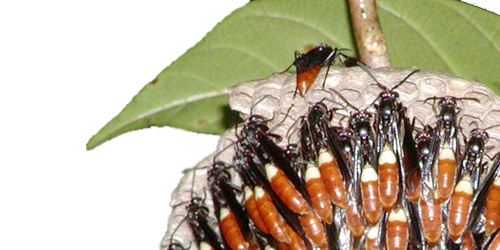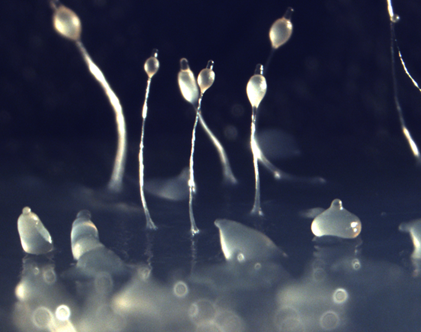I feel amazing.
I am so energetic, I can barely contain it. Anyone who has spoken to me on the phone lately can attest. For the last two weeks, my energy and strength has been rising every day, and now I feel better than I’ve felt in years. In early 2007, I was in a brief remission, and I felt wonderful, like I’d felt years before—before the fatigue set it, which happened three full years before my diagnosis in 2006. I now feel as good as I did during my remission, which can only be good news.
Reasons for my quick recovery are many: Being able to eat, no more diarrhea, and, most recently, the cessation of a particularly nasty treatment. That treatment, with the drug ganciclovir, is for infection with CMV, cytomegalovirus, the a virus that in healthy people causes mononucleosis‡. I was taking this drug probably because of a hospital error. In order to explain, a brief digression into biology is required. (Regular readers shouldn’t be much surprised.)
CMV is one of the most commonly transmitted viruses on the earth. The probability of contracting CMV rises with every year over one’s lifetime, and virtually everyone has it by middle age. Despite this, I luckily tested negative in my pre-transplant blood tests. Even more luckily, my donor was also negative. This was great news, as CMV can cause blindness, serious lung problems, meningitis, and death in immunosuppressed people—facts that I remember all too well from my AIDS activism days in the late ’80s and early ’90s. My early blood tests found no antibodies for CMV, and a highly sensitive test for CMV’s DNA, called PCR (for polymerase chain reaction), also showed negative initially. However, three weeks into my transplant, a weekly PCR test was positive. This was somewhat odd.
CMV is a herpes virus, and like all herpes viruses (including the virus that causes chickenpox [Herpes zoster]; Epstein-Barr virus; and of course, Herpes simplex I and II), CMV can hide inside cells that it infects, inserting itself into our cellular DNA. When this is the case, a DNA test of blood might well be negative. So if the CMV became active later, a previously negative PCR could become positive. That part wasn’t the odd piece. The odd part was my antibody negativity.
Antibodies are those amazing, disease-specific chemicals that our body produces in response to invasion by viral infections. For every virus that infects us, we have a different antibody (well, almost). But I was antibody negative for CMV, and that was the weird piece. If I had been infected before, and the CMV had become quiescent, and then reactivated three weeks after my transplant, I would’ve been antibody positive the whole time. But despite my suspicions of the apparently discordant blood tests, the positive PCR meant action had to be taken, and fast. Because of the great risk of CMV infection, my physician rightly put me on ganciclovir immediately.
The great thing about ganciclovir is that it is very successful in defeating CMV. I remember when ganciclovir came to market; it was a revolution for people with AIDS. Prior to ganciclovir, having AIDS often meant the loss of sight, or worse. And nothing could be done to stop CMV. Ganciclovir changed all that. But the bad news about ganciclovir is that it suppresses the production of blood cells, especially white blood cells. After I began taking the ganciclovir, all of the components of my blood—my platelets, red blood cells, and white blood cells all crashed. After an unusually fast and strong engraftment of my donor’s stem cells, which resulted in my having normal or near-normal blood counts for the first time in years, I was back to square one, and continuing to take the drug kept me there. And to boot, after this blood cell crash, I contracted that awful C. difficile infection. Administration of ganciclovir has a known association with infections like C. difficile. I had to be treated for the apparent CMV infection, but the treatment made me fragile.
Two weeks ago, my DNA test for CMV was negative, as it had been every time after the first test. I asked my physician why I would not have anti-CMV antibodies if I had CMV (again, antibodies are always produced when we’re exposed to an infection, and we keep them forever). After some discussion, my physician agreed that this was odd, and hypothesized that perhaps I’d acquired the CMV infection from one of my many pre- and post-transplant blood transfusions. But that didn’t explain everything, and I left that meeting unconvinced.
Over the next week I puzzled over all my clinical data. Why was I antibody negative? Maybe it was because my immune system was so shot that it couldn’t produce any antibodies. That is very likely true, but even so, I should still have residual (and easily detectable) antibodies from before the transplant, as they remain in the blood months after they are created. Considering the DNA tests, I wondered how the ganciclovir could have eradicated the infection so quickly; I’d started taking the drug on a Thursday evening, and by the following Tuesday morning all evidence of the viral DNA was gone. Ganciclovir is a good drug, but that good? I asked about this the following week (last week). My physician—who is remarkable in being open to discussion and input—considered my concerns and took a third look at the data, treating them all together. The negative antibody test, the lone positive PCR result, and the rapid PCR negativity that never reversed—they just didn’t add up. After this, my physician concluded that the first CMV test may well have been a false negative positive (this can happen with PCR, because this DNA test is extremely sensitive, and in labs where these tests are run routinely [like mine], contamination can be a serious problem). As a result, we decided to stop the ganciclovir. My blood cells, in theory, should begin to rise again.
So, yesterday when Greg and I went to the hospital for my weekly appointment, we were a bit disappointed that my blood cells had not rebounded more. My hematocrit (one measure of red blood cells) was a bit higher, my white blood cells had gained 500 cells per squared cm (up from ~1,100), but my platelets were down from 80,000 to 50, 000 (both well below normal)—a mixed result.
But given how amazing I feel, I wasn’t too worried about this. I did ask about the possibility of graft failure—a topic I’ll take up a bit later—but looking at the data on the proportion of “my” blood cells that are truly mine verses from my doner, everything looked excellent.
Stem cell transplant is an unlikely business. Juggling all the variables—the risk of infection, the risk of Graft Versus Host Disease, the many drugs, the side effects of those drugs—managing all these can all be . . . well . . . at times impossible for both the physician and patient. This procedure is truly at the bleeding edge of our knowledge, and much of what goes on, and why certain aspects of the therapy work or don’t, is yet unknown. When in a situation like this, in my experience two factors are indispensable: patient self-advocacy, and physician finesse. Having cut my teeth on AIDS activism, I have no problem telling physicians that this is my body, and we must work together, as co-equal partners, to manage my illness, treatments, and recovery. My current physician agrees, unusually, and we cooperate to achieve our common goal. That cooperation is a big part of why I’m so energetic and healthy today.
And it’s good to feel great for the first time in a long time.
‡UPDATE: See this post.

























